Strategic Management: Porter's Five Forces Analysis and Developments
VerifiedAdded on 2020/03/16
|11
|2762
|69
Report
AI Summary
This report provides an in-depth analysis of Porter's Five Forces, a crucial framework in strategic management. It explores how the model helps organizations assess their competitive environment and profitability. The report covers the core concepts of the five forces: threat of new entrants, bargaining power of suppliers, bargaining power of buyers, threat of substitutes, and rivalry among existing competitors. It also examines recent developments and extensions of the model, such as the incorporation of competitive advantage and the impact of factors like information technology and investment. The analysis highlights the interdependencies of the forces and their influence on strategic decision-making. The report concludes by emphasizing the model's significance in shaping business strategies and adapting to dynamic market conditions. Several academic sources are cited to support the arguments.
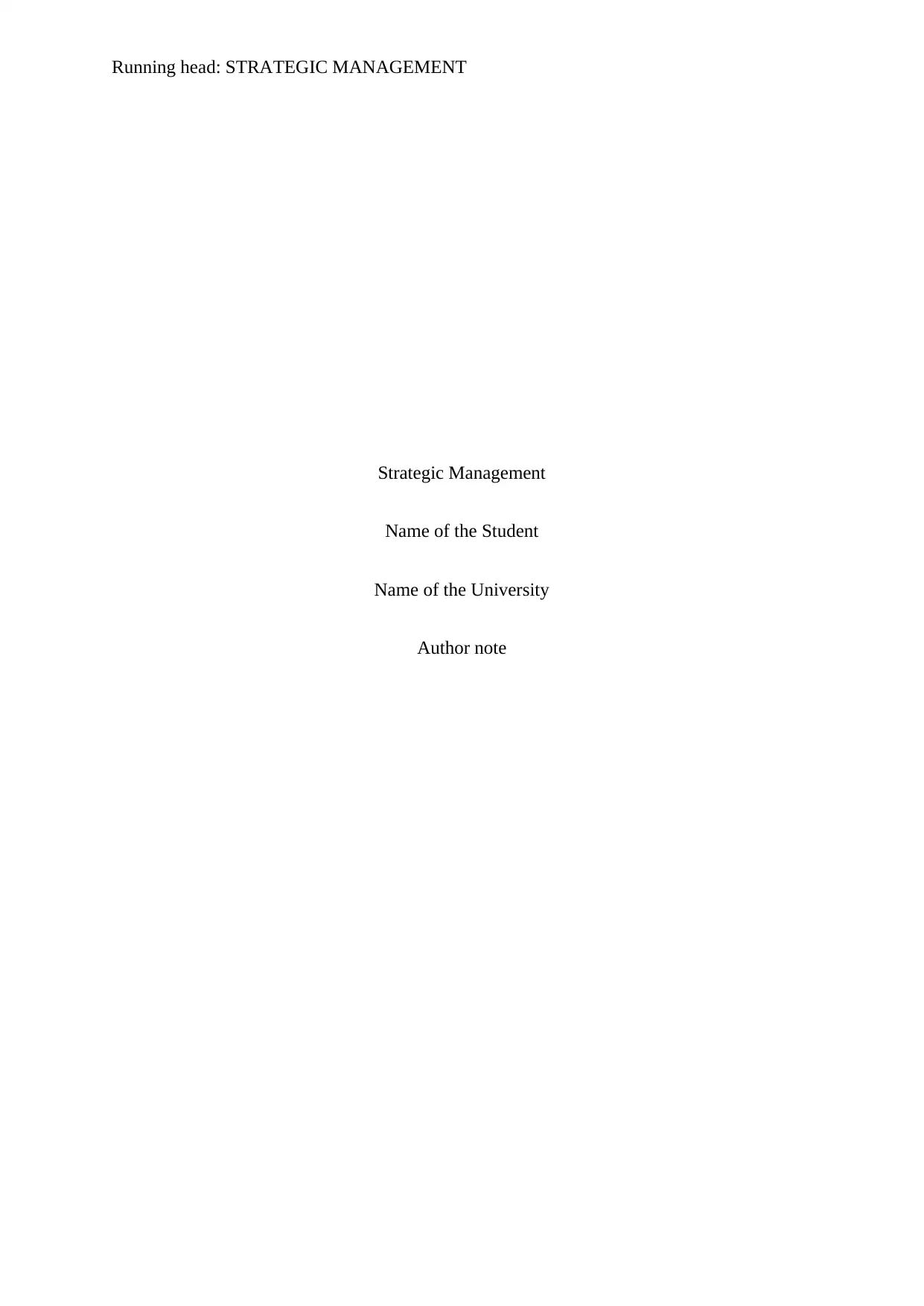
Running head: STRATEGIC MANAGEMENT
Strategic Management
Name of the Student
Name of the University
Author note
Strategic Management
Name of the Student
Name of the University
Author note
Paraphrase This Document
Need a fresh take? Get an instant paraphrase of this document with our AI Paraphraser
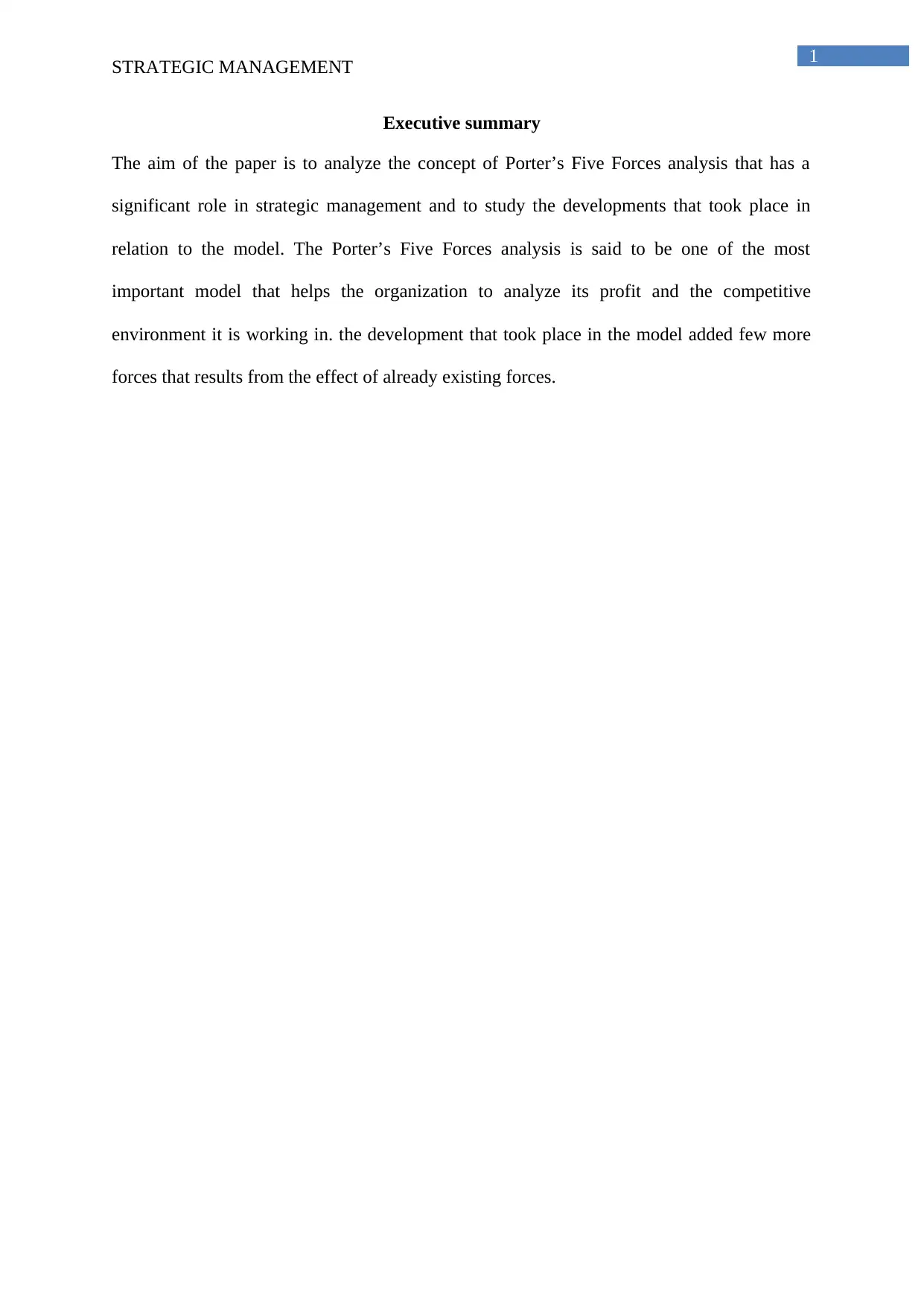
1
STRATEGIC MANAGEMENT
Executive summary
The aim of the paper is to analyze the concept of Porter’s Five Forces analysis that has a
significant role in strategic management and to study the developments that took place in
relation to the model. The Porter’s Five Forces analysis is said to be one of the most
important model that helps the organization to analyze its profit and the competitive
environment it is working in. the development that took place in the model added few more
forces that results from the effect of already existing forces.
STRATEGIC MANAGEMENT
Executive summary
The aim of the paper is to analyze the concept of Porter’s Five Forces analysis that has a
significant role in strategic management and to study the developments that took place in
relation to the model. The Porter’s Five Forces analysis is said to be one of the most
important model that helps the organization to analyze its profit and the competitive
environment it is working in. the development that took place in the model added few more
forces that results from the effect of already existing forces.
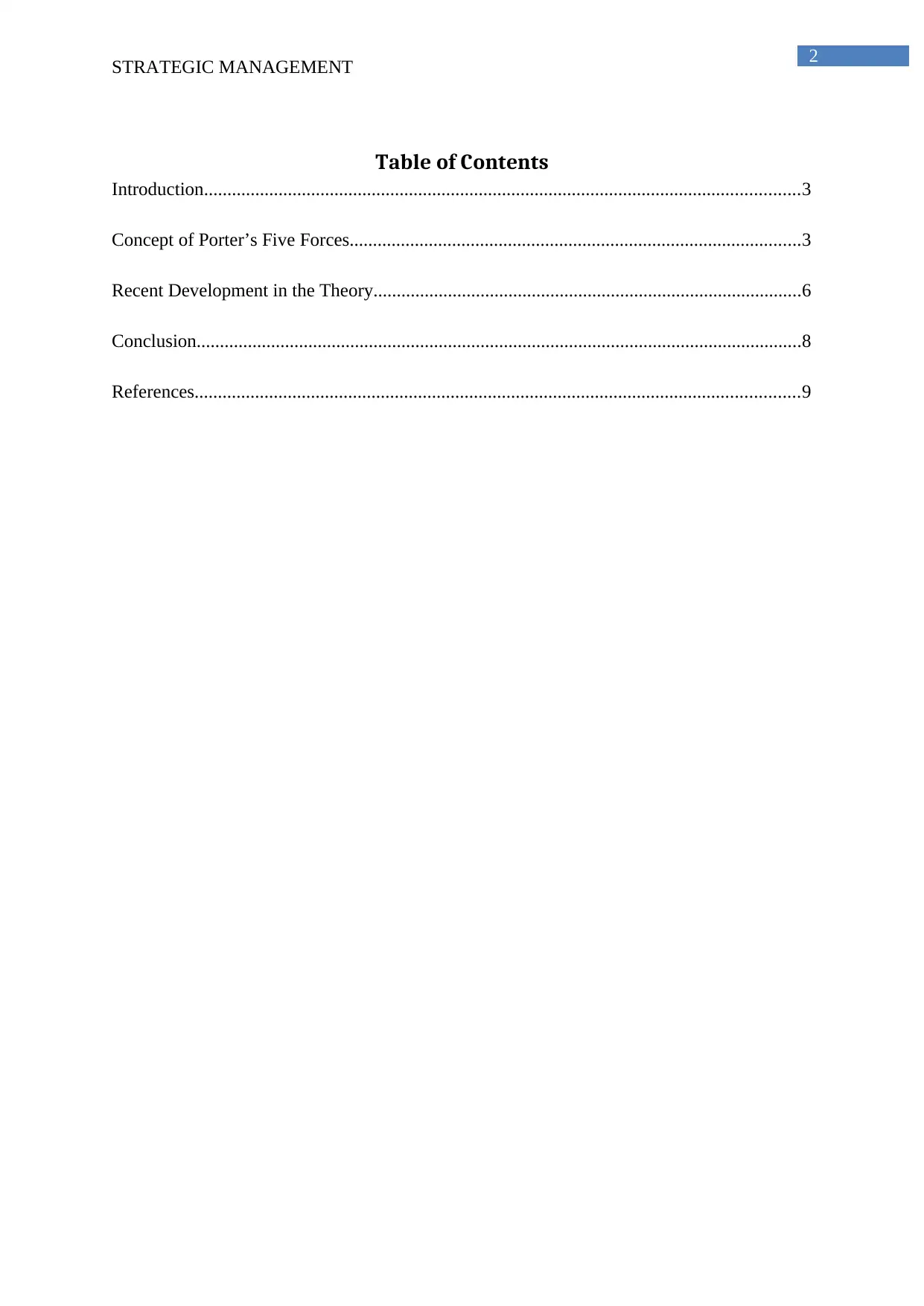
2
STRATEGIC MANAGEMENT
Table of Contents
Introduction................................................................................................................................3
Concept of Porter’s Five Forces.................................................................................................3
Recent Development in the Theory............................................................................................6
Conclusion..................................................................................................................................8
References..................................................................................................................................9
STRATEGIC MANAGEMENT
Table of Contents
Introduction................................................................................................................................3
Concept of Porter’s Five Forces.................................................................................................3
Recent Development in the Theory............................................................................................6
Conclusion..................................................................................................................................8
References..................................................................................................................................9
⊘ This is a preview!⊘
Do you want full access?
Subscribe today to unlock all pages.

Trusted by 1+ million students worldwide

3
STRATEGIC MANAGEMENT
Introduction
Strategic management is explained as an initiative that the company takes through its
management team to achieve certain goals of the organization. It helps the organization to
analyze its internal and external environment that it might face while formulating the goals
and activities of the company. Various strategies and concepts help the managers to carry out
effective strategic management for the company through value chain analysis, marketing mix
analysis, Porter’s Five Forces analysis, and Resource-based analysis. Each of these concepts
has its own importance and role in helping the company to take various decisions in relation
to its growth and development. The paper discusses about the role Porter’s Five Forces play
in defining the strategic management of a company. Further, it describes the recent
development that took place in relation to the concept by analyzing various literatures.
Porter’s Five Forces is one of the best concepts that a company can use to analyze the threat it
is receiving from various sources both internally and externally.
Concept of Porter’s Five Forces
Porter’s Five Forces analysis is a framework that helps in analyzing the competition
of the business. The concept has been drawn from the economics of industrial organization
that shows the intensity of competition the company faces from other sources. Further, the
amount of competition also helps the company to understand its attractiveness in the market.
It also shows that if the customers are not attracted to the company then it will reduce the
profitability of the company. This is because an unattractive company receives more threat
from the outside world such as the competitors, suppliers and others. Porter’s in other words
means the microenvironment that the company faces from the macro environment. The forces
described by Porter’s shows the inability of the company to serve its customers and gain
maximum profit for the business Terpend and Krause (2015). The five forces that need to be
STRATEGIC MANAGEMENT
Introduction
Strategic management is explained as an initiative that the company takes through its
management team to achieve certain goals of the organization. It helps the organization to
analyze its internal and external environment that it might face while formulating the goals
and activities of the company. Various strategies and concepts help the managers to carry out
effective strategic management for the company through value chain analysis, marketing mix
analysis, Porter’s Five Forces analysis, and Resource-based analysis. Each of these concepts
has its own importance and role in helping the company to take various decisions in relation
to its growth and development. The paper discusses about the role Porter’s Five Forces play
in defining the strategic management of a company. Further, it describes the recent
development that took place in relation to the concept by analyzing various literatures.
Porter’s Five Forces is one of the best concepts that a company can use to analyze the threat it
is receiving from various sources both internally and externally.
Concept of Porter’s Five Forces
Porter’s Five Forces analysis is a framework that helps in analyzing the competition
of the business. The concept has been drawn from the economics of industrial organization
that shows the intensity of competition the company faces from other sources. Further, the
amount of competition also helps the company to understand its attractiveness in the market.
It also shows that if the customers are not attracted to the company then it will reduce the
profitability of the company. This is because an unattractive company receives more threat
from the outside world such as the competitors, suppliers and others. Porter’s in other words
means the microenvironment that the company faces from the macro environment. The forces
described by Porter’s shows the inability of the company to serve its customers and gain
maximum profit for the business Terpend and Krause (2015). The five forces that need to be
Paraphrase This Document
Need a fresh take? Get an instant paraphrase of this document with our AI Paraphraser
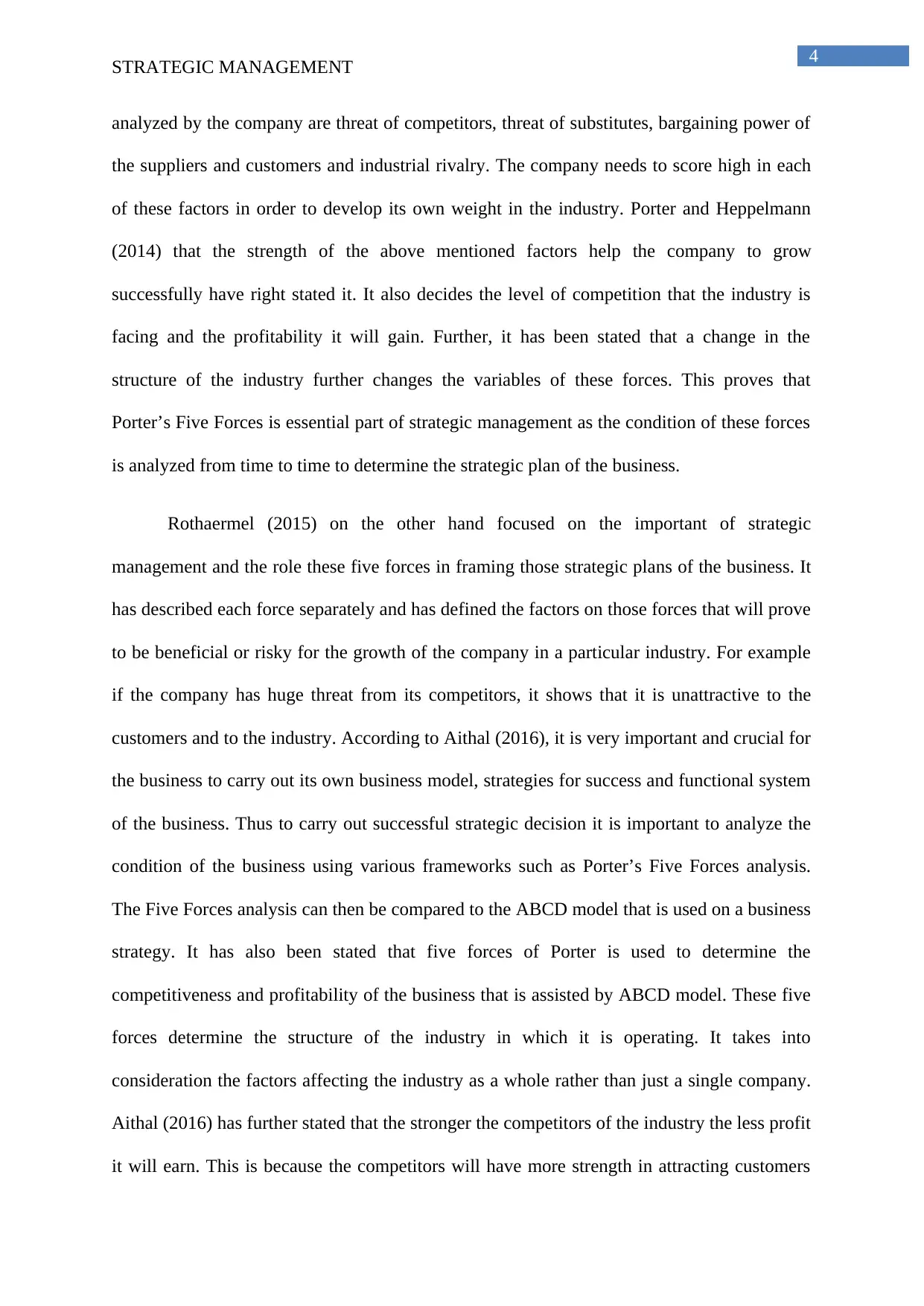
4
STRATEGIC MANAGEMENT
analyzed by the company are threat of competitors, threat of substitutes, bargaining power of
the suppliers and customers and industrial rivalry. The company needs to score high in each
of these factors in order to develop its own weight in the industry. Porter and Heppelmann
(2014) that the strength of the above mentioned factors help the company to grow
successfully have right stated it. It also decides the level of competition that the industry is
facing and the profitability it will gain. Further, it has been stated that a change in the
structure of the industry further changes the variables of these forces. This proves that
Porter’s Five Forces is essential part of strategic management as the condition of these forces
is analyzed from time to time to determine the strategic plan of the business.
Rothaermel (2015) on the other hand focused on the important of strategic
management and the role these five forces in framing those strategic plans of the business. It
has described each force separately and has defined the factors on those forces that will prove
to be beneficial or risky for the growth of the company in a particular industry. For example
if the company has huge threat from its competitors, it shows that it is unattractive to the
customers and to the industry. According to Aithal (2016), it is very important and crucial for
the business to carry out its own business model, strategies for success and functional system
of the business. Thus to carry out successful strategic decision it is important to analyze the
condition of the business using various frameworks such as Porter’s Five Forces analysis.
The Five Forces analysis can then be compared to the ABCD model that is used on a business
strategy. It has also been stated that five forces of Porter is used to determine the
competitiveness and profitability of the business that is assisted by ABCD model. These five
forces determine the structure of the industry in which it is operating. It takes into
consideration the factors affecting the industry as a whole rather than just a single company.
Aithal (2016) has further stated that the stronger the competitors of the industry the less profit
it will earn. This is because the competitors will have more strength in attracting customers
STRATEGIC MANAGEMENT
analyzed by the company are threat of competitors, threat of substitutes, bargaining power of
the suppliers and customers and industrial rivalry. The company needs to score high in each
of these factors in order to develop its own weight in the industry. Porter and Heppelmann
(2014) that the strength of the above mentioned factors help the company to grow
successfully have right stated it. It also decides the level of competition that the industry is
facing and the profitability it will gain. Further, it has been stated that a change in the
structure of the industry further changes the variables of these forces. This proves that
Porter’s Five Forces is essential part of strategic management as the condition of these forces
is analyzed from time to time to determine the strategic plan of the business.
Rothaermel (2015) on the other hand focused on the important of strategic
management and the role these five forces in framing those strategic plans of the business. It
has described each force separately and has defined the factors on those forces that will prove
to be beneficial or risky for the growth of the company in a particular industry. For example
if the company has huge threat from its competitors, it shows that it is unattractive to the
customers and to the industry. According to Aithal (2016), it is very important and crucial for
the business to carry out its own business model, strategies for success and functional system
of the business. Thus to carry out successful strategic decision it is important to analyze the
condition of the business using various frameworks such as Porter’s Five Forces analysis.
The Five Forces analysis can then be compared to the ABCD model that is used on a business
strategy. It has also been stated that five forces of Porter is used to determine the
competitiveness and profitability of the business that is assisted by ABCD model. These five
forces determine the structure of the industry in which it is operating. It takes into
consideration the factors affecting the industry as a whole rather than just a single company.
Aithal (2016) has further stated that the stronger the competitors of the industry the less profit
it will earn. This is because the competitors will have more strength in attracting customers

5
STRATEGIC MANAGEMENT
towards them then this industry. This makes it necessary for the industry to carry out an
analysis regarding their competitors and shape their strategies accordingly. Among the all-
strategic management models such as SWOT, PESTLE and others, Porter’s Five Forces is
perceived to be the best because of the strength of analysis it offers for an industry. it is the
way the five forces of the business is analyzed to know the extent to which the industry can
make profit at present and in near future and the chances it will allow new entrants into the
industry. This strength of these forces helps the new start-ups to decide the kind of industry
they seek to enter in order to make their business a success. The strength of the forces is said
to be inversely related with the profit a business can earn. In other words, the stronger a force
is the more the profit will go down.
Mathooko and Ogutu (2015) have discussed the role played by each force separately
and the importance they have on the company operating in the industry. The risk of new
entrant shows the possibility that the company will have the chance of earning good profit in
the industry it is operating will be over. On the other hand, the possibility of increasing
competition shows the failure of the company in gaining economies of scale in the industry it
is operating. Bargaining power of the suppliers show the cost that the company will incur in
its products and bargaining power of customers show the limit to which it can charge price
from the consumers. Lastly, the threat from substitute shows the effect of actions of the
substitute company on the demand of this particular company. Thus, each of the forces pays a
crucial role in defining the stricture and strategies of a company. Eskandari et al. (2015) in
their paper has discussed about the importance of one force of Porter’s Five Forces model
and that is competitiveness. It shows the ability and competences that the firm holds in the
industry in which it is operating its business. The more the competitiveness of the firm the
less chance other firms in the industry gets to access the industry and its customers. The
competitiveness of the business is defined by both its internal and external factors. The
STRATEGIC MANAGEMENT
towards them then this industry. This makes it necessary for the industry to carry out an
analysis regarding their competitors and shape their strategies accordingly. Among the all-
strategic management models such as SWOT, PESTLE and others, Porter’s Five Forces is
perceived to be the best because of the strength of analysis it offers for an industry. it is the
way the five forces of the business is analyzed to know the extent to which the industry can
make profit at present and in near future and the chances it will allow new entrants into the
industry. This strength of these forces helps the new start-ups to decide the kind of industry
they seek to enter in order to make their business a success. The strength of the forces is said
to be inversely related with the profit a business can earn. In other words, the stronger a force
is the more the profit will go down.
Mathooko and Ogutu (2015) have discussed the role played by each force separately
and the importance they have on the company operating in the industry. The risk of new
entrant shows the possibility that the company will have the chance of earning good profit in
the industry it is operating will be over. On the other hand, the possibility of increasing
competition shows the failure of the company in gaining economies of scale in the industry it
is operating. Bargaining power of the suppliers show the cost that the company will incur in
its products and bargaining power of customers show the limit to which it can charge price
from the consumers. Lastly, the threat from substitute shows the effect of actions of the
substitute company on the demand of this particular company. Thus, each of the forces pays a
crucial role in defining the stricture and strategies of a company. Eskandari et al. (2015) in
their paper has discussed about the importance of one force of Porter’s Five Forces model
and that is competitiveness. It shows the ability and competences that the firm holds in the
industry in which it is operating its business. The more the competitiveness of the firm the
less chance other firms in the industry gets to access the industry and its customers. The
competitiveness of the business is defined by both its internal and external factors. The
⊘ This is a preview!⊘
Do you want full access?
Subscribe today to unlock all pages.

Trusted by 1+ million students worldwide
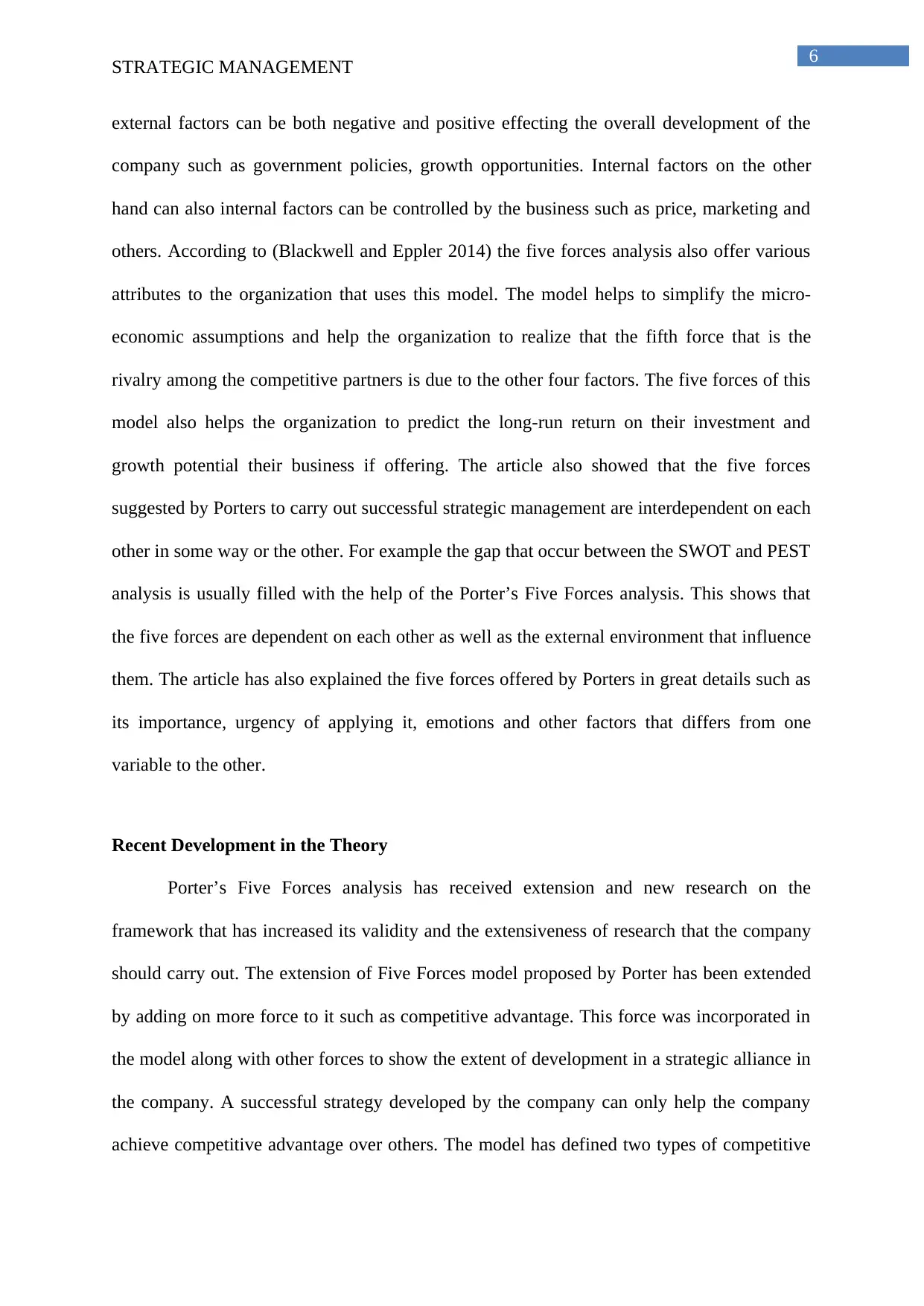
6
STRATEGIC MANAGEMENT
external factors can be both negative and positive effecting the overall development of the
company such as government policies, growth opportunities. Internal factors on the other
hand can also internal factors can be controlled by the business such as price, marketing and
others. According to (Blackwell and Eppler 2014) the five forces analysis also offer various
attributes to the organization that uses this model. The model helps to simplify the micro-
economic assumptions and help the organization to realize that the fifth force that is the
rivalry among the competitive partners is due to the other four factors. The five forces of this
model also helps the organization to predict the long-run return on their investment and
growth potential their business if offering. The article also showed that the five forces
suggested by Porters to carry out successful strategic management are interdependent on each
other in some way or the other. For example the gap that occur between the SWOT and PEST
analysis is usually filled with the help of the Porter’s Five Forces analysis. This shows that
the five forces are dependent on each other as well as the external environment that influence
them. The article has also explained the five forces offered by Porters in great details such as
its importance, urgency of applying it, emotions and other factors that differs from one
variable to the other.
Recent Development in the Theory
Porter’s Five Forces analysis has received extension and new research on the
framework that has increased its validity and the extensiveness of research that the company
should carry out. The extension of Five Forces model proposed by Porter has been extended
by adding on more force to it such as competitive advantage. This force was incorporated in
the model along with other forces to show the extent of development in a strategic alliance in
the company. A successful strategy developed by the company can only help the company
achieve competitive advantage over others. The model has defined two types of competitive
STRATEGIC MANAGEMENT
external factors can be both negative and positive effecting the overall development of the
company such as government policies, growth opportunities. Internal factors on the other
hand can also internal factors can be controlled by the business such as price, marketing and
others. According to (Blackwell and Eppler 2014) the five forces analysis also offer various
attributes to the organization that uses this model. The model helps to simplify the micro-
economic assumptions and help the organization to realize that the fifth force that is the
rivalry among the competitive partners is due to the other four factors. The five forces of this
model also helps the organization to predict the long-run return on their investment and
growth potential their business if offering. The article also showed that the five forces
suggested by Porters to carry out successful strategic management are interdependent on each
other in some way or the other. For example the gap that occur between the SWOT and PEST
analysis is usually filled with the help of the Porter’s Five Forces analysis. This shows that
the five forces are dependent on each other as well as the external environment that influence
them. The article has also explained the five forces offered by Porters in great details such as
its importance, urgency of applying it, emotions and other factors that differs from one
variable to the other.
Recent Development in the Theory
Porter’s Five Forces analysis has received extension and new research on the
framework that has increased its validity and the extensiveness of research that the company
should carry out. The extension of Five Forces model proposed by Porter has been extended
by adding on more force to it such as competitive advantage. This force was incorporated in
the model along with other forces to show the extent of development in a strategic alliance in
the company. A successful strategy developed by the company can only help the company
achieve competitive advantage over others. The model has defined two types of competitive
Paraphrase This Document
Need a fresh take? Get an instant paraphrase of this document with our AI Paraphraser
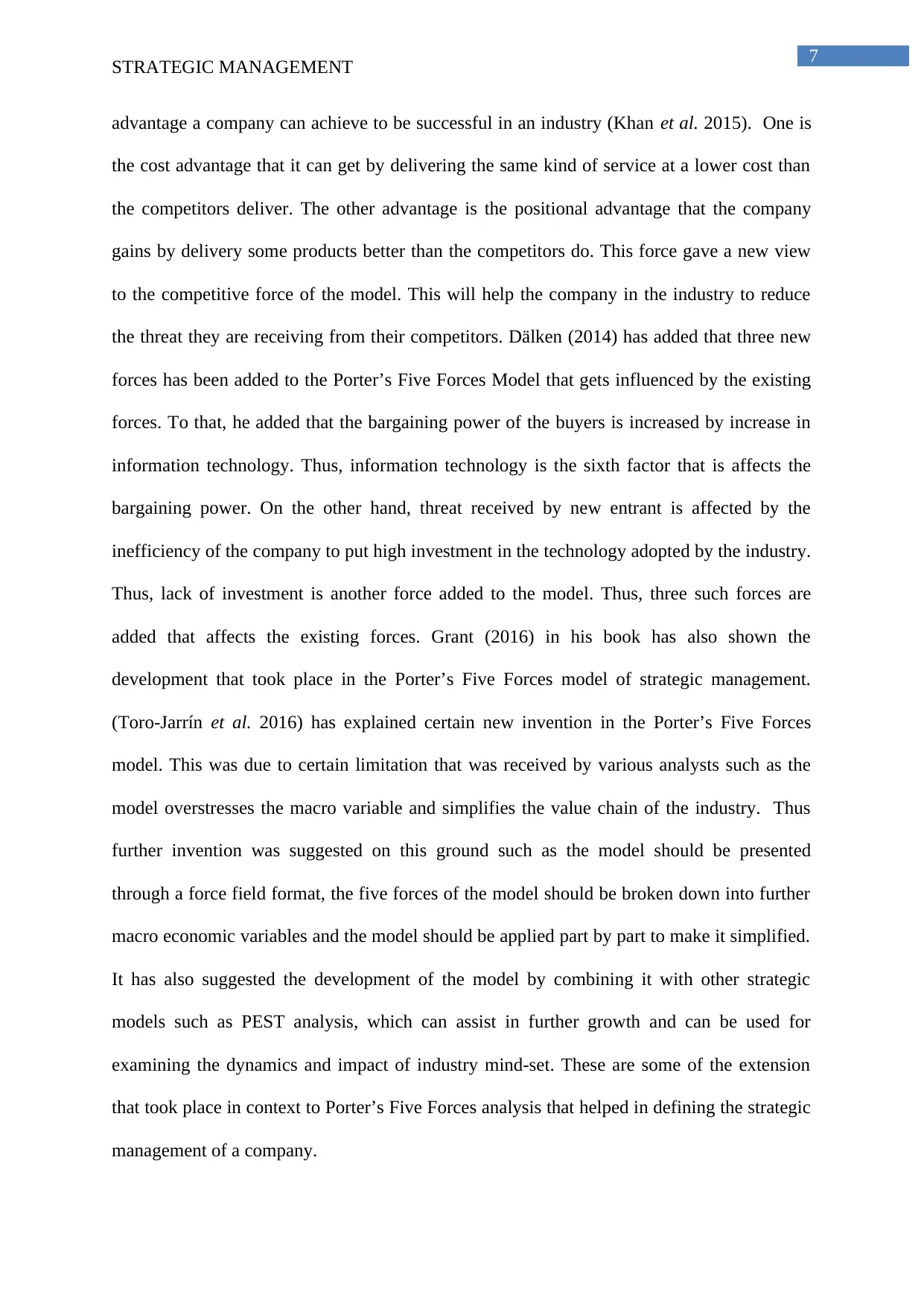
7
STRATEGIC MANAGEMENT
advantage a company can achieve to be successful in an industry (Khan et al. 2015). One is
the cost advantage that it can get by delivering the same kind of service at a lower cost than
the competitors deliver. The other advantage is the positional advantage that the company
gains by delivery some products better than the competitors do. This force gave a new view
to the competitive force of the model. This will help the company in the industry to reduce
the threat they are receiving from their competitors. Dälken (2014) has added that three new
forces has been added to the Porter’s Five Forces Model that gets influenced by the existing
forces. To that, he added that the bargaining power of the buyers is increased by increase in
information technology. Thus, information technology is the sixth factor that is affects the
bargaining power. On the other hand, threat received by new entrant is affected by the
inefficiency of the company to put high investment in the technology adopted by the industry.
Thus, lack of investment is another force added to the model. Thus, three such forces are
added that affects the existing forces. Grant (2016) in his book has also shown the
development that took place in the Porter’s Five Forces model of strategic management.
(Toro-Jarrín et al. 2016) has explained certain new invention in the Porter’s Five Forces
model. This was due to certain limitation that was received by various analysts such as the
model overstresses the macro variable and simplifies the value chain of the industry. Thus
further invention was suggested on this ground such as the model should be presented
through a force field format, the five forces of the model should be broken down into further
macro economic variables and the model should be applied part by part to make it simplified.
It has also suggested the development of the model by combining it with other strategic
models such as PEST analysis, which can assist in further growth and can be used for
examining the dynamics and impact of industry mind-set. These are some of the extension
that took place in context to Porter’s Five Forces analysis that helped in defining the strategic
management of a company.
STRATEGIC MANAGEMENT
advantage a company can achieve to be successful in an industry (Khan et al. 2015). One is
the cost advantage that it can get by delivering the same kind of service at a lower cost than
the competitors deliver. The other advantage is the positional advantage that the company
gains by delivery some products better than the competitors do. This force gave a new view
to the competitive force of the model. This will help the company in the industry to reduce
the threat they are receiving from their competitors. Dälken (2014) has added that three new
forces has been added to the Porter’s Five Forces Model that gets influenced by the existing
forces. To that, he added that the bargaining power of the buyers is increased by increase in
information technology. Thus, information technology is the sixth factor that is affects the
bargaining power. On the other hand, threat received by new entrant is affected by the
inefficiency of the company to put high investment in the technology adopted by the industry.
Thus, lack of investment is another force added to the model. Thus, three such forces are
added that affects the existing forces. Grant (2016) in his book has also shown the
development that took place in the Porter’s Five Forces model of strategic management.
(Toro-Jarrín et al. 2016) has explained certain new invention in the Porter’s Five Forces
model. This was due to certain limitation that was received by various analysts such as the
model overstresses the macro variable and simplifies the value chain of the industry. Thus
further invention was suggested on this ground such as the model should be presented
through a force field format, the five forces of the model should be broken down into further
macro economic variables and the model should be applied part by part to make it simplified.
It has also suggested the development of the model by combining it with other strategic
models such as PEST analysis, which can assist in further growth and can be used for
examining the dynamics and impact of industry mind-set. These are some of the extension
that took place in context to Porter’s Five Forces analysis that helped in defining the strategic
management of a company.
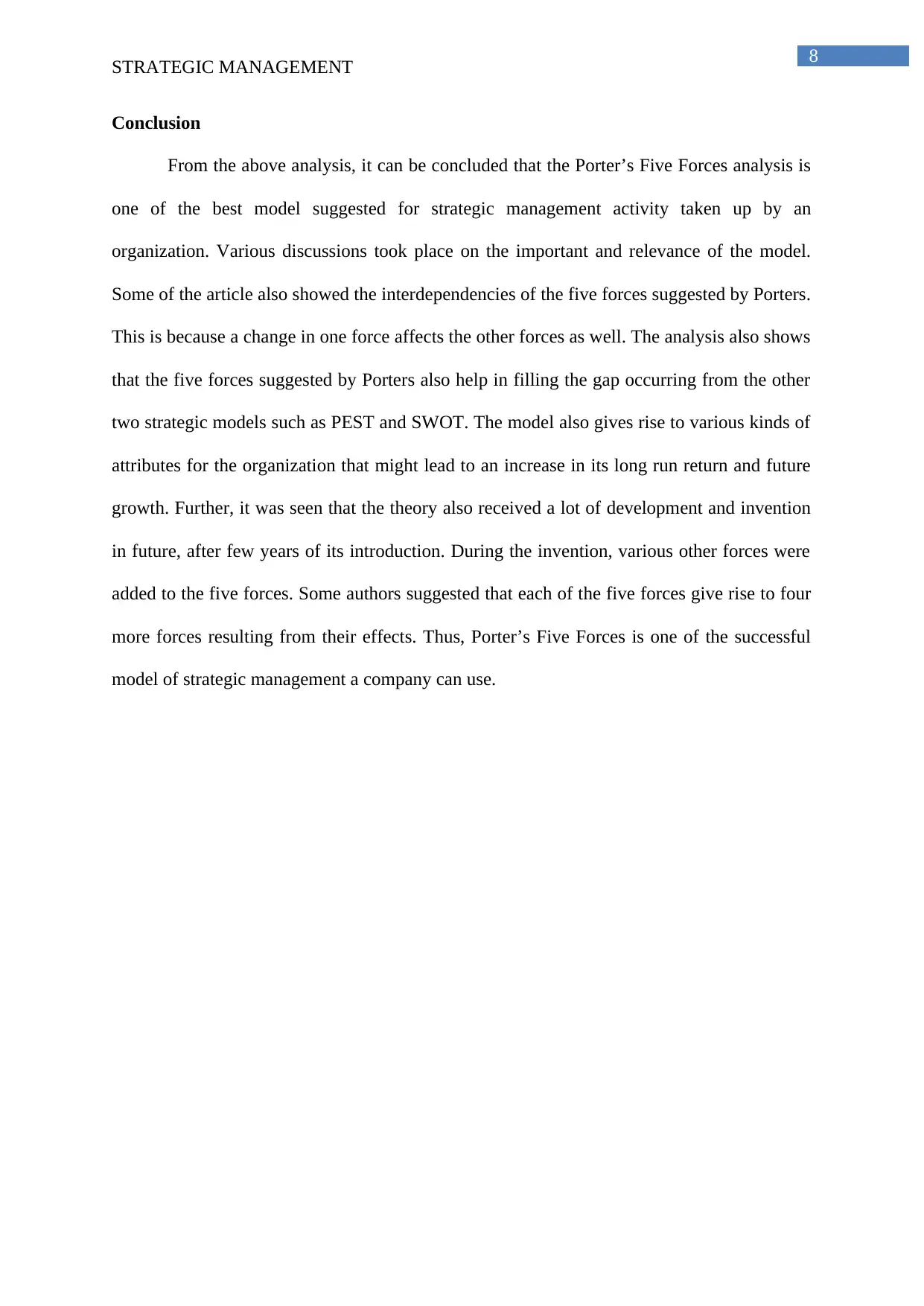
8
STRATEGIC MANAGEMENT
Conclusion
From the above analysis, it can be concluded that the Porter’s Five Forces analysis is
one of the best model suggested for strategic management activity taken up by an
organization. Various discussions took place on the important and relevance of the model.
Some of the article also showed the interdependencies of the five forces suggested by Porters.
This is because a change in one force affects the other forces as well. The analysis also shows
that the five forces suggested by Porters also help in filling the gap occurring from the other
two strategic models such as PEST and SWOT. The model also gives rise to various kinds of
attributes for the organization that might lead to an increase in its long run return and future
growth. Further, it was seen that the theory also received a lot of development and invention
in future, after few years of its introduction. During the invention, various other forces were
added to the five forces. Some authors suggested that each of the five forces give rise to four
more forces resulting from their effects. Thus, Porter’s Five Forces is one of the successful
model of strategic management a company can use.
STRATEGIC MANAGEMENT
Conclusion
From the above analysis, it can be concluded that the Porter’s Five Forces analysis is
one of the best model suggested for strategic management activity taken up by an
organization. Various discussions took place on the important and relevance of the model.
Some of the article also showed the interdependencies of the five forces suggested by Porters.
This is because a change in one force affects the other forces as well. The analysis also shows
that the five forces suggested by Porters also help in filling the gap occurring from the other
two strategic models such as PEST and SWOT. The model also gives rise to various kinds of
attributes for the organization that might lead to an increase in its long run return and future
growth. Further, it was seen that the theory also received a lot of development and invention
in future, after few years of its introduction. During the invention, various other forces were
added to the five forces. Some authors suggested that each of the five forces give rise to four
more forces resulting from their effects. Thus, Porter’s Five Forces is one of the successful
model of strategic management a company can use.
⊘ This is a preview!⊘
Do you want full access?
Subscribe today to unlock all pages.

Trusted by 1+ million students worldwide
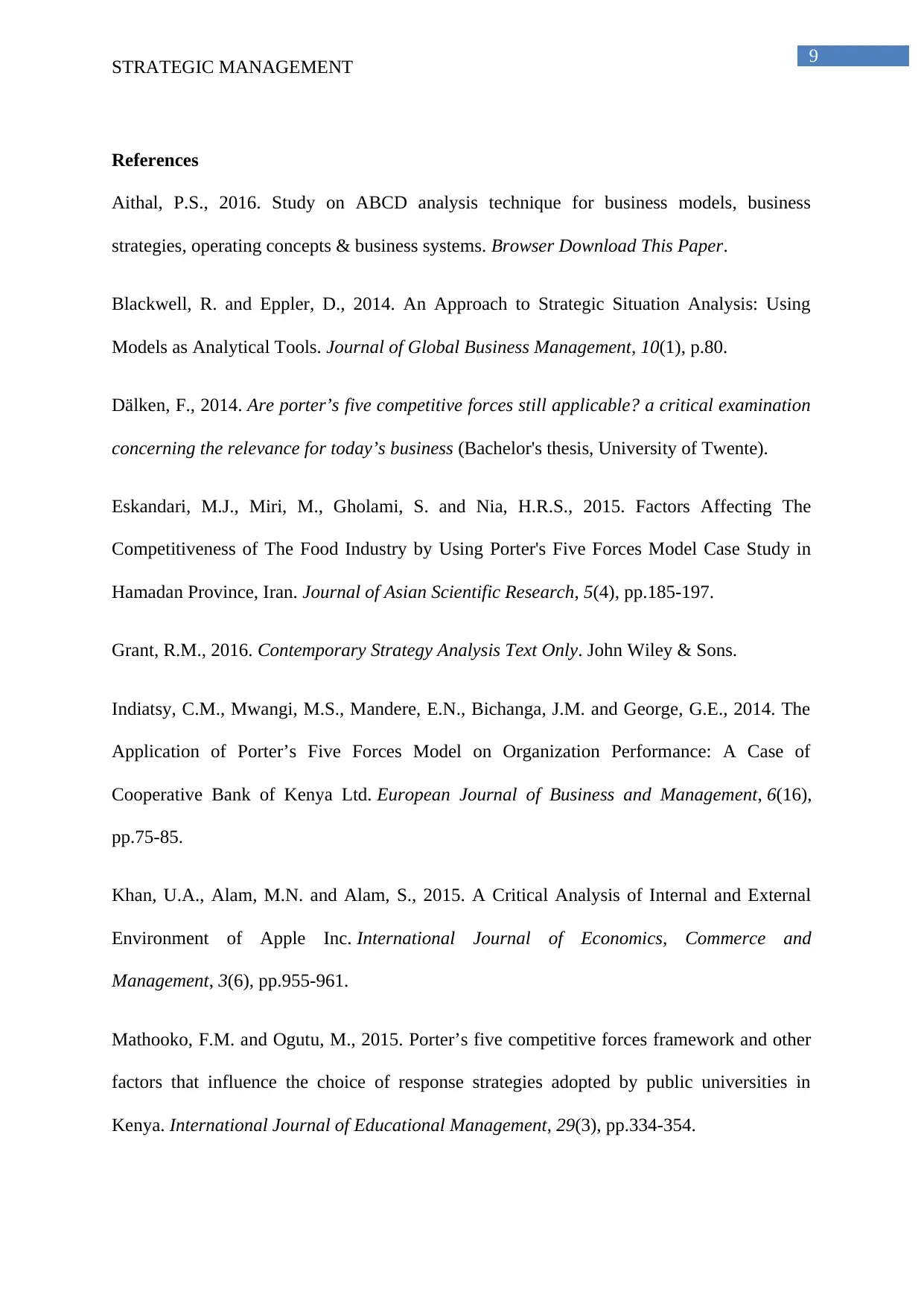
9
STRATEGIC MANAGEMENT
References
Aithal, P.S., 2016. Study on ABCD analysis technique for business models, business
strategies, operating concepts & business systems. Browser Download This Paper.
Blackwell, R. and Eppler, D., 2014. An Approach to Strategic Situation Analysis: Using
Models as Analytical Tools. Journal of Global Business Management, 10(1), p.80.
Dälken, F., 2014. Are porter’s five competitive forces still applicable? a critical examination
concerning the relevance for today’s business (Bachelor's thesis, University of Twente).
Eskandari, M.J., Miri, M., Gholami, S. and Nia, H.R.S., 2015. Factors Affecting The
Competitiveness of The Food Industry by Using Porter's Five Forces Model Case Study in
Hamadan Province, Iran. Journal of Asian Scientific Research, 5(4), pp.185-197.
Grant, R.M., 2016. Contemporary Strategy Analysis Text Only. John Wiley & Sons.
Indiatsy, C.M., Mwangi, M.S., Mandere, E.N., Bichanga, J.M. and George, G.E., 2014. The
Application of Porter’s Five Forces Model on Organization Performance: A Case of
Cooperative Bank of Kenya Ltd. European Journal of Business and Management, 6(16),
pp.75-85.
Khan, U.A., Alam, M.N. and Alam, S., 2015. A Critical Analysis of Internal and External
Environment of Apple Inc. International Journal of Economics, Commerce and
Management, 3(6), pp.955-961.
Mathooko, F.M. and Ogutu, M., 2015. Porter’s five competitive forces framework and other
factors that influence the choice of response strategies adopted by public universities in
Kenya. International Journal of Educational Management, 29(3), pp.334-354.
STRATEGIC MANAGEMENT
References
Aithal, P.S., 2016. Study on ABCD analysis technique for business models, business
strategies, operating concepts & business systems. Browser Download This Paper.
Blackwell, R. and Eppler, D., 2014. An Approach to Strategic Situation Analysis: Using
Models as Analytical Tools. Journal of Global Business Management, 10(1), p.80.
Dälken, F., 2014. Are porter’s five competitive forces still applicable? a critical examination
concerning the relevance for today’s business (Bachelor's thesis, University of Twente).
Eskandari, M.J., Miri, M., Gholami, S. and Nia, H.R.S., 2015. Factors Affecting The
Competitiveness of The Food Industry by Using Porter's Five Forces Model Case Study in
Hamadan Province, Iran. Journal of Asian Scientific Research, 5(4), pp.185-197.
Grant, R.M., 2016. Contemporary Strategy Analysis Text Only. John Wiley & Sons.
Indiatsy, C.M., Mwangi, M.S., Mandere, E.N., Bichanga, J.M. and George, G.E., 2014. The
Application of Porter’s Five Forces Model on Organization Performance: A Case of
Cooperative Bank of Kenya Ltd. European Journal of Business and Management, 6(16),
pp.75-85.
Khan, U.A., Alam, M.N. and Alam, S., 2015. A Critical Analysis of Internal and External
Environment of Apple Inc. International Journal of Economics, Commerce and
Management, 3(6), pp.955-961.
Mathooko, F.M. and Ogutu, M., 2015. Porter’s five competitive forces framework and other
factors that influence the choice of response strategies adopted by public universities in
Kenya. International Journal of Educational Management, 29(3), pp.334-354.
Paraphrase This Document
Need a fresh take? Get an instant paraphrase of this document with our AI Paraphraser
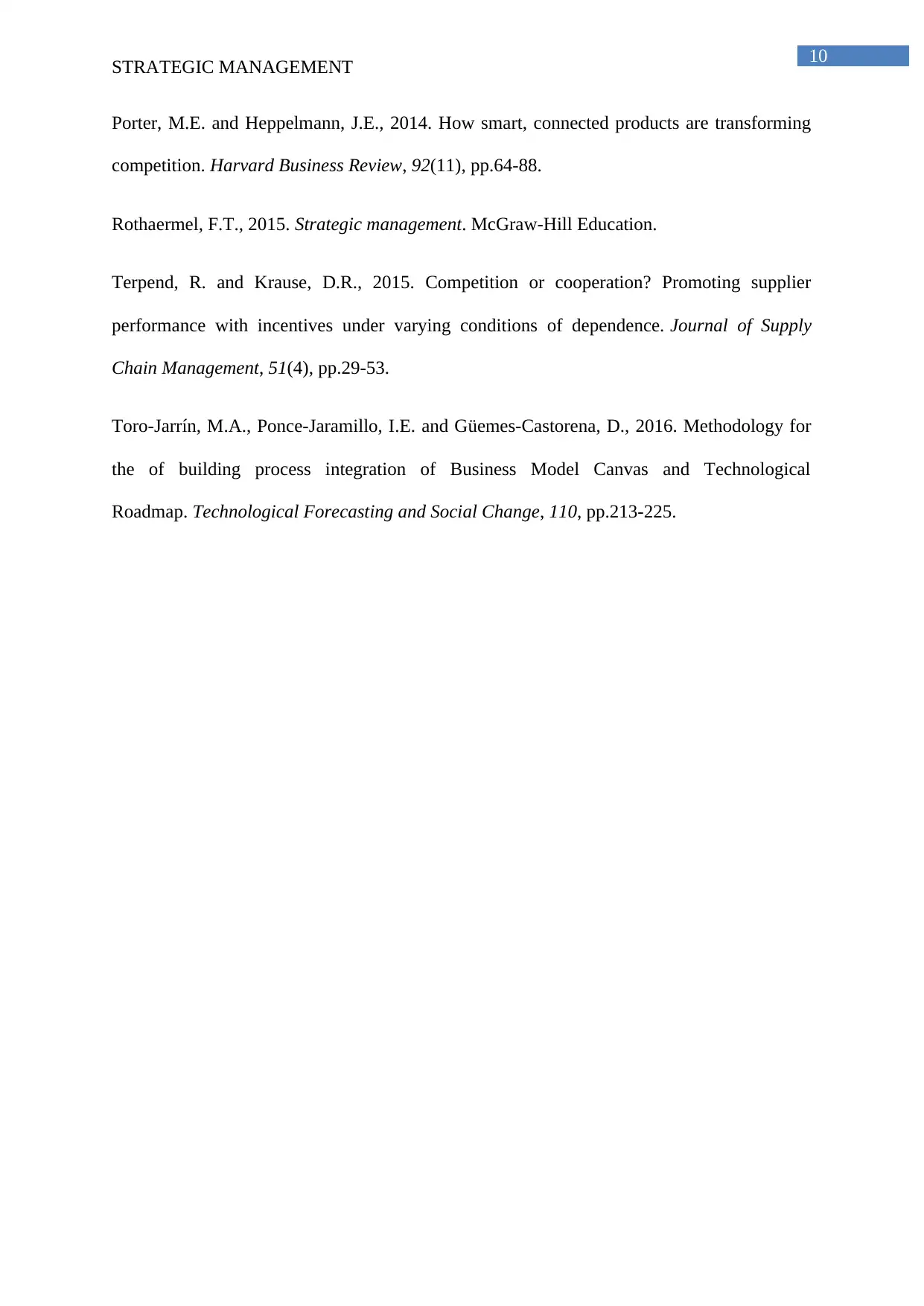
10
STRATEGIC MANAGEMENT
Porter, M.E. and Heppelmann, J.E., 2014. How smart, connected products are transforming
competition. Harvard Business Review, 92(11), pp.64-88.
Rothaermel, F.T., 2015. Strategic management. McGraw-Hill Education.
Terpend, R. and Krause, D.R., 2015. Competition or cooperation? Promoting supplier
performance with incentives under varying conditions of dependence. Journal of Supply
Chain Management, 51(4), pp.29-53.
Toro-Jarrín, M.A., Ponce-Jaramillo, I.E. and Güemes-Castorena, D., 2016. Methodology for
the of building process integration of Business Model Canvas and Technological
Roadmap. Technological Forecasting and Social Change, 110, pp.213-225.
STRATEGIC MANAGEMENT
Porter, M.E. and Heppelmann, J.E., 2014. How smart, connected products are transforming
competition. Harvard Business Review, 92(11), pp.64-88.
Rothaermel, F.T., 2015. Strategic management. McGraw-Hill Education.
Terpend, R. and Krause, D.R., 2015. Competition or cooperation? Promoting supplier
performance with incentives under varying conditions of dependence. Journal of Supply
Chain Management, 51(4), pp.29-53.
Toro-Jarrín, M.A., Ponce-Jaramillo, I.E. and Güemes-Castorena, D., 2016. Methodology for
the of building process integration of Business Model Canvas and Technological
Roadmap. Technological Forecasting and Social Change, 110, pp.213-225.
1 out of 11
Related Documents
Your All-in-One AI-Powered Toolkit for Academic Success.
+13062052269
info@desklib.com
Available 24*7 on WhatsApp / Email
![[object Object]](/_next/static/media/star-bottom.7253800d.svg)
Unlock your academic potential
Copyright © 2020–2025 A2Z Services. All Rights Reserved. Developed and managed by ZUCOL.





